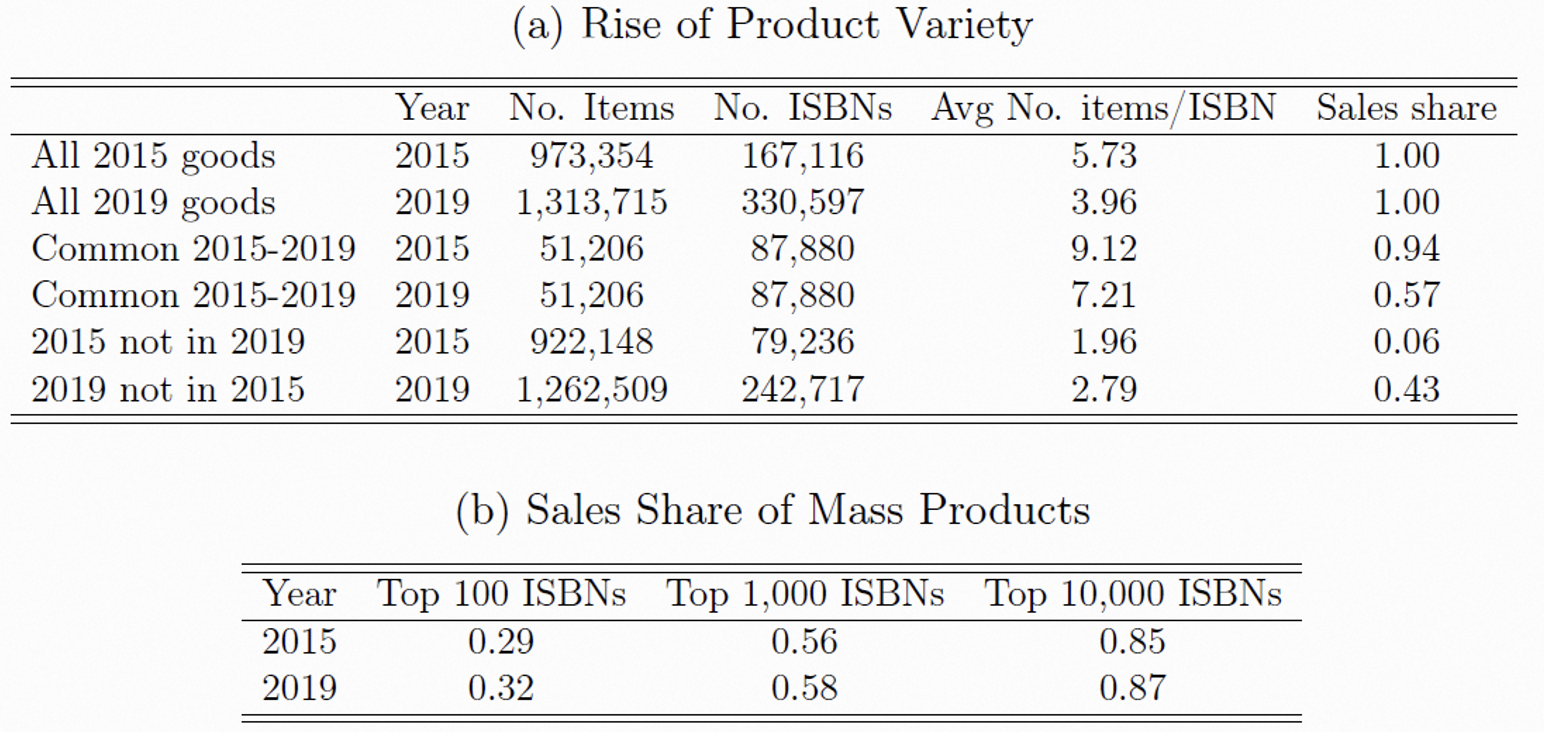The internet and platform technologies have facilitated coordination among large sets of buyers and sellers, transforming the retail market. By integrating markets and reducing the cost of distribution, online platforms provide a large and growing set of product choices to consumers. In 2000, there were around five million stock keeping units (SKUs) on Amazon, and the number of products increased 100 times to an astonishing 500 million SKUs by 2016. On the largest digital platform in China, the overall number of items offered more than tripled in just four years, rising from about one billion items to more than three billion items between 2015 and 2019. According to Euromonitor, e-commerce sales as a percentage of total retail sales in 2020 exceeded 27% in China and 20% in the US.
Brynjolfsson et al. (2003) first documented the extent to which online platforms could radically increase consumer choice, reflecting the fact that these products benefit disproportionately from lower search costs. Anderson (2004) coined the term ‘the long tail’ to describe this phenomenon. Digital platforms cater to the needs of consumers with unusual tastes by showcasing and distributing a large selection of product choices. While there has been growing attention to the importance of new products in the economy since the seminal work on the topic by Bresnahan and Gordon (1996), there is little recent empirical evidence on the rapidly growing role of niche products.
In Brynjolfsson et al. (2022), we use detailed data from the largest e-commerce platform in China to document large increases in product variety in recent years, and quantify the associated welfare gains for consumers. We obtain detailed transaction data for three categories of books from the e-commerce platform. An advantage of examining books is that each title is classified using a unique International Standard Book Number (ISBN); measured by their ISBNs, we find that the number of products increased by 98% from 2015 to 2019.
We define the top 1,000 ISBNs as mass products, and find that they account for just under 60% of market share in both years. However, they account for only 0.6% of the total ISBNs available in 2015, and 0.3% of ISBNs in 2019, which implies that most of the increase in product variety has been among niche products. In fact, we find that the average market share of a new ISBN is only about 29% that of a surviving ISBN. There are also fewer listings selling new ISBNs, on average 2.8 for a new ISBN and 7.2 for a surviving ISBN. Table 1 shows the large increase in product variety between 2015 and 2019, and illustrates the niche nature of new varieties.
Table 1 Product variety in 2015 and 2019
To quantify the gains from increased product variety, we posit a simple two-segment constant elasticity of substitution (CES) framework, which allows heterogeneity in demand elasticity for mass products and niche products. The advantage of CES demand is that we can infer the surplus generated by new products from the expenditure shares. Conditional on the level of expenditure shares of new products, the gains will be larger when new products are less substitutable than existing products. If the demand for niche products is less elastic than it is for mass products, neglecting the difference in demand elasticities would underestimate the gains from variety.
We estimate demand elasticity for mass and niche products separately using an exogenous driver of variation of prices and quantities sold. Our estimates indicate that demand is less elastic for niche products: in 2015, a 1% increase in price translates to a 1.9% decrease in quantities sold for mass products, but only a 1.5% decrease for niche products. Embedding the estimates into the model, we find that the gain from increased variety is about 120% the total expenditure on books in 2019, roughly 40 times larger than the gain derived from price effect alone. To put the number into perspective, for the three categories of books in our sample, consumer gains from variety total about 1.45 billion yuan, a welfare gain 30% higher than an approach which does not distinguish between mass and niche products.
We further explore geographic heterogeneity by estimating gains from variety at the county level. Accounting for heterogeneity in demand elasticity reveals that rural consumers enjoy larger gains from variety, possibly due to the fact that they have limited access to product variety via traditional brick-and-mortar stores, thus benefiting more from the rise of an online channel.
Our results also have implications for competition between sellers and the nature of product creation in the online market. We find demand is more elastic for mass products, which is inconsistent with the theoretic result in Neiman and Vavra (2019) and can be explained by more competition within the market of mass products. Besides, our estimates of demand elasticity suggest a relatively modest level of price competition on the e-commerce platform, reflecting the large scope of product differentiation even within a seemingly standardised book market. A seller could use advertising, marketing, and product design decisions to influence a consumer’s valuations and soften price competition (Johnson and Myatt 2006, Bar-Isaac et al. 2012).
Furthermore, our framework does not explicitly model the search and information frictions in the process of consumer decision making. In a dynamic setting where these types of frictions are incorporated, product differentiation could also be a source of obfuscation, increasing search costs and reducing consumer welfare (Ellison and Ellison 2009). Finally, we find the average demand elasticity decreases over time in our sample, which raises concerns about rising market power in the product market. Understanding the trend of product market power has been a focus of recent research, as in the work of De Loecker et al. (2020). Although the primary aim of our research is not to evaluate changes in market power, it is important to realise that the fraction of retail taking place on the online platforms has been growing rapidly. Therefore, the future evolution of aggregate market power will be increasingly influenced by online competition. These are interesting questions that we hope to pursue in future work.
References
Anderson, C (2004), “The long tail”, Wired 12(10): 170–177.
Bar-Isaac, H, G Caruana V and Cuñat (2012), “Search, design, and market structure”, American Economic Review 102(2): 1140–60.
Bresnahan, T F and R J Gordon (1996), The Economics of New Goods, Vol. 58, University of Chicago Press.
Brynjolfsson, E, Y Hu, and M D Smith (2003), “Consumer surplus in the digital economy: Estimating the value of increased product variety at online booksellers”, Management Science 49(11): 1580–1596.
Brynjolfsson, E, L Chen and X Gao (2022), “Gains from Product Variety: Evidence from a Large Digital Platform”, NBER Working Paper No. 30802.
De Loecker, J, J Eeckhout and G Unger (2020), “The rise of market power and the macroeconomic implications”, The Quarterly Journal of Economics 135(2): 561–644.
Ellison, G and S F Ellison (2009), “Search, obfuscation, and price elasticities on the internet”, Econometrica 77(2): 427–452.
Johnson, J P and D P Myatt (2006), “On the simple economics of advertising, marketing, and product design”, American Economic Review 96(3): 756–784.
Neiman, B and J S Vavra (2019), “The rise of niche consumption”, VoxEU.org, 26 September.







